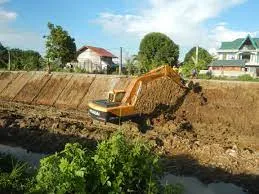Definition:Canal lining is the engineering practice of applying an impermeable layer to the bed and sides of a canal. This layer minimizes water loss due to seepage, which can be significant in unlined canals, reaching 30-50% of the total water flow.
Click the Translate button(see right) on this post to set your Own Language to understand more perfectly!!
Canal Lining Calculator
Continue Definition: Canal Lining
Soil Permeability:
Soil Texture
Average Permeability (cm/hour)
Sand
5.0
Sandy Loam
2.5
Loam
1.3
Clay Loam
0.8
Silty Clay
0.25
Clay
0.1
Canal lining is the engineering practice of applying an impermeable layer to the bed and sides of a canal. This layer minimizes water loss due to seepage, which can be significant in unlined canals, reaching 30-50% of the total water flow.
Properties of Canal Lining:
Impermeability: The primary function of a canal lining is to be watertight, preventing water from seeping into the surrounding soil.
Durability: The lining material needs to withstand constant water exposure, weather elements, and potential erosion from the water flow.
Strength: The lining should be strong enough to handle the weight of the water and any external loads it might encounter.
Smoothness: A smooth lining reduces friction between the water and the canal walls, allowing for improved water flow efficiency.
Cost-effectiveness: The chosen lining material should offer a balance between effectiveness and affordability.
Supporting Equation:
One important equation used in canal design related to lining is the Manning's equation, which helps calculate the velocity of water flow in open channels like canals.
Manning's equation:
V = (1/n) * R^(2/3) * S^(1/2)
Where:
V - Average velocity of water flow (m/s)
n - Manning's roughness coefficient (dimensionless) - A value that depends on the friction between the water and the canal lining material. Lower 'n' values indicate smoother surfaces and higher flow rates.
R - Hydraulic radius (m) - The area of the water flow section divided by its wetted perimeter.
S - Slope of the canal bed (m/m)
Example:
A concrete canal lining is designed for a canal with a bottom width of 5 meters, side slopes of 1:1 (horizontal:vertical), and a water depth of 2 meters. The canal bed slope is 0.001 (1 meter drop per kilometer).
Step 1: Calculate the wetted perimeter (P):
P = bottom width + 2 * water depth * (1 + slope^2)^1/2
P = 5 + 2 * 2 * (1 + 0.001^2)^1/2
P ≈ 9.02 meters
Step 2: Calculate the flow area (A):
A = bottom width * water depth + (water depth^2) * slope
A = 5 * 2 + (2^2) * 0.001
A = 10.002 meters^2
Step 3: Calculate the hydraulic radius (R):
R = A / P
R = 10.002 / 9.02
R ≈ 1.11 meters
Step 4: Assuming a Manning's roughness coefficient (n) for concrete of 0.013:
We can use Manning's equation to estimate the average water velocity (V) in the canal. However, due to the complexity of the equation, it's easier to solve for V using computational tools or pre-made tables based on Manning's equation.
This is a simplified example, and actual canal design involves various factors and considerations beyond this basic example
How to earn from the Canal Lining Calculator in our real life application????
There are several potential ways to earn from a Canal Lining Calculator in a real-life application, depending on the specific features and target audience. Here are a few possibilities:
Subscription Model:
Offer a premium version of the calculator with advanced features like:
Material cost estimation based on user-defined locations
Integration with design software for seamless data transfer
Access to a library of standard canal lining designs
Advanced reports and analysis tools
Freemium Model:
Provide a basic free version of the calculator with limited functionality.
Offer in-app purchases to unlock additional features like:
Handling complex canal geometries
Considering specific water flow scenarios
Detailed reports with downloadable formats
Data-as-a-Service (DaaS):
Partner with construction companies or material suppliers and offer access to:
Regional data on material costs and availability
Historical data on project costs and timelines
Analytics on popular canal lining choices for different scenarios
Consultation Services:
Leverage the expertise behind the calculator to offer:
Consulting services for choosing the optimal canal lining solution
Design review and optimization based on calculator outputs
Training and workshops on canal lining design using the calculator
Advertising:
Integrate targeted advertising from material suppliers or construction companies within the free version of the calculator.
The best way to earn will depend on your target audience and the features you offer. Here are some additional factors to consider:
Market demand: Is there a need for a user-friendly canal lining calculator in your target market?
Competition: Are there existing solutions, and how does your calculator differentiate itself?
Value proposition: What unique benefits does your calculator offer to users?
By carefully considering these factors, you can develop a monetization strategy that maximizes the earning potential of your Canal Lining Calculator.
Do YOU Want To Earn Money In Various Ways, Click The Link & Explore Your Field of Interest!!!









No comments:
Post a Comment